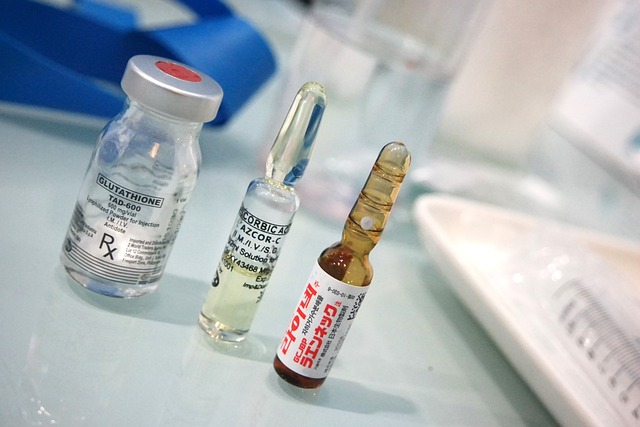Semaglutide injections, an innovative glucagon-like peptide-1 (GLP-1) receptor agonist, offer a powerful and convenient solution for managing type 2 diabetes. Its once-weekly injectable form mimics natural GLP-1 to stimulate insulin, suppress glucagon, and control blood sugar levels. Clinical trials show significant HbA1c reduction, weight loss, and improved cardiovascular outcomes, making it a game-changer in diabetes treatment. The semaglutide injectable form provides superior glycemic control compared to many other medications, with potential benefits like reduced appetite and weight management. Combining it with lifestyle modifications enhances overall glycemic management and quality of life for patients.
“Discover the transformative power of Semaglutide injections as a leading glycemic control solution. This comprehensive guide explores the science behind this innovative therapy, its role in managing Type 2 Diabetes, and the mechanisms that make it an effective tool. From understanding the drug’s unique properties to its administration techniques and real-world impact, we delve into the benefits of Semaglutide injectable form, offering a holistic view for healthcare professionals and patients alike.”
Understanding Semaglutide and Its Injectable Form

Semaglutide, a type of glucagon-like peptide-1 (GLP-1) receptor agonist, has emerged as a powerful tool in glycemic control for individuals with type 2 diabetes. This injectable form of semaglutide offers a unique and effective approach to managing blood sugar levels. By mimicking the action of the natural hormone GLP-1, it stimulates insulin secretion when blood sugar is high and suppresses glucagon release, helping to lower glucose levels.
The semaglutide injectable form is administered once weekly, providing convenience and sustained control. It’s known for its ability to reduce HbA1c (average blood glucose) significantly compared to placebo, often with weight loss as an added benefit. This makes it a game-changer in diabetes management, especially for those who struggle with traditional oral medications.
Glycemic Control: The Role of Semaglutide Injections

Glycemic control is a critical aspect of managing diabetes, aiming to maintain blood sugar levels within a healthy range. Semaglutide injections play a pivotal role in achieving this balance. As a highly effective glucagon-like peptide-1 (GLP-1) receptor agonist, semaglutide mimics the natural hormone GLP-1, which stimulates insulin secretion when blood sugar is high and suppresses glucagon release, thus lowering glucose levels.
The injectable form of semaglutide offers a once-weekly administration, providing convenience and consistent glycemic management. This long-acting medication has shown remarkable results in clinical trials, significantly reducing HbA1c (a marker of long-term blood sugar control) compared to placebo or other treatments. Its ability to promote weight loss and improve cardiovascular outcomes further highlights the versatility of semaglutide injections in comprehensive diabetes care.
How Semaglutide Injections Work for Diabetes Management

Semaglutide injections play a significant role in diabetes management, offering an innovative approach to glycemic control. This injectable form of semaglutide mimics a natural hormone, known as GLP-1 (glucagon-like peptide-1), which is produced by the body’s gut. By mimicking this hormone, semaglutide injections help regulate blood sugar levels in people with type 2 diabetes or obesity-related conditions.
The mechanism of action involves several key processes. Semaglutide stimulates insulin secretion when blood sugar levels are high, promoting glucose uptake into cells. It also suppresses glucagon release, which reduces liver glucose production. This dual effect leads to improved insulin sensitivity and better control of blood sugar, making semaglutide injections a valuable tool for maintaining stable glycemic levels and enhancing overall diabetes management.
Benefits of Using Semaglutide in Type 2 Diabetes Treatment

The semaglutide injectable form has emerged as a powerful tool in the management of Type 2 diabetes, offering several significant benefits for patients and healthcare providers. One of its key advantages is its ability to provide superior glycemic control compared to many other available medications. This is achieved through its unique mechanism of action, where it mimics the effects of the natural hormone GLP-1, which stimulates insulin production and suppresses glucagon secretion, leading to improved blood sugar regulation.
Additionally, semaglutide has been shown to promote weight loss, a crucial aspect in managing Type 2 diabetes, as obesity is often associated with insulin resistance. The injectable form’s long-acting properties also mean that it can be administered less frequently than other insulin therapies, potentially improving patient compliance and quality of life. These benefits make semaglutide a promising and effective treatment option for many individuals living with Type 2 diabetes.
The Administration Process: Semaglutide Injection Techniques

The administration process of semaglutide involves a simple injection technique, making it an accessible option for glycemic control. This medication is typically injected once weekly, allowing for convenient long-term management of type 2 diabetes. Healthcare providers offer guidance on proper injection sites, ensuring optimal absorption and minimal discomfort. The injectable form of semaglutide is designed to mimic the natural hormone GLP-1, which stimulates insulin production and suppresses glucagon release, leading to improved blood sugar levels.
The injection technique involves selecting a suitable area, usually the abdomen, thigh, or upper arm, rotating the site with each dose to prevent lipohypertrophy (lips accumulation under the skin). The needle is inserted at an angle, delivering the medication effectively into the subcutaneous tissue. Patients are taught on proper needle disposal and cleaning of the injection site post-administration, emphasizing hygiene to minimize infection risks.
Potential Side Effects and Safety Considerations

The semaglutide injectable form, like any medication, comes with potential side effects that should be considered. Common issues include gastrointestinal problems such as nausea, vomiting, and diarrhea, which are often reported early in treatment. These symptoms usually lessen over time as your body adjusts to the medication. Additionally, some users have experienced changes in taste perception and a reduced appetite, which can lead to weight loss. While these side effects may be bothersome, they do not necessarily indicate a serious problem.
Safety considerations are paramount when using semaglutide. It’s crucial to monitor blood sugar levels regularly, as the drug can lower glucose dramatically. Hypoglycemia, or low blood sugar, is a possible risk, especially when combining semaglutide with other diabetes medications. Other important safety notes include the potential for allergic reactions and the need to inform healthcare providers about any existing medical conditions or medications before starting treatment. Regular check-ups are essential to ensure the therapy remains beneficial and safe for each individual’s health profile.
Real-Life Success Stories: Patient Experiences with Semaglutide

In real-life scenarios, the semaglutide injectable form has been a game-changer for many patients struggling with glycemic control. These success stories highlight how effective this medication can be in managing type 2 diabetes. Patients often report significant improvements in their blood sugar levels, leading to better overall health and an improved quality of life. The once daunting task of constantly monitoring glucose levels and administering insulin injections becomes more manageable with semaglutide, allowing individuals to gain a sense of control over their condition.
Many patients share their experiences with healthcare providers, emphasizing the convenience and effectiveness of semaglutide. The injectable form offers a simple and efficient way to manage diabetes, reducing the complexity often associated with traditional insulin therapy. These positive patient encounters not only serve as testimonials but also reinforce the potential benefits of semaglutide for those considering it as a treatment option.
Combining Semaglutide with Lifestyle Modifications for Optimal Results

Combining Semaglutide with Lifestyle Modifications for Optimal Results
For individuals aiming to achieve and maintain optimal glycemic control, integrating semaglutide injectable form into a comprehensive management strategy is highly beneficial. This involves not only regular administration of the medication but also embracing significant lifestyle modifications. Adopting a balanced diet, rich in whole grains, fruits, and vegetables, alongside regular physical activity, plays a crucial role in enhancing insulin sensitivity and further improving glucose levels.
Additionally, stress management techniques such as mindfulness meditation or yoga can complement semaglutide therapy by reducing stress hormones that negatively impact blood sugar regulation. Adequate sleep is another often-overlooked aspect; ensuring consistent, quality rest supports the body’s natural rhythms and aids in maintaining stable glycemic levels. By intertwining these lifestyle adjustments with semaglutide injections, individuals can achieve more significant and sustainable results in their quest for excellent glycemic control.
Future Perspectives on Semaglutide Injectable Form in Diabetes Care

The future of diabetes management looks promising with semaglutide’s growing role in glycemic control. As research progresses, the focus on improving patient quality of life through enhanced therapy options remains a priority. The semaglutide injectable form has already shown significant advantages, offering a once-weekly administration schedule compared to daily injections for many other diabetes medications. This shift could dramatically improve medication adherence and convenience for patients.
Additionally, ongoing studies explore the potential benefits of semaglutide beyond glycemic control, including weight management and cardiovascular risk reduction. Optimizing these aspects could make semaglutide injectable form an even more versatile tool in managing type 2 diabetes and its associated complications. These future perspectives highlight the exciting possibilities that lie ahead for this innovative therapy.
